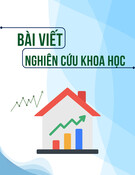
Hue University Journal of Science: Economics and Development
pISSN 2588-1205;eISSN 2615-9716
Vol. 133, No. 5C, 2024, pp. 43–65, DOI: 10.26459/hueunijed.v133i5C.7620
FORMAL CREDIT, RURAL HOUSEHOLD LIVING
STANDARDS: A STUDY OF THE NORTH CENTRAL REGION
OF VIETNAM
Le Viet Giap*, Nguyen Thi Khanh Trang, Pham Quoc Khang, Nguyen The Hung
University of Economics, Hue University, 99 Ho Dac Di St., Hue, Vietnam
* Correspondence to Le Viet Giap <lvgiap@hce.edu.vn>
(Submitted: September 1, 2024; Accepted: September 27, 2024)
Abstract. This study focuses on evaluating the impact of access to formal credit on the living standards of
rural households in the North Central region of Vietnam. The propensity score matching (PSM) method was
used on the Vietnam Household Living Standards Survey (VHLSS) 2020 database to examine this impact.
The research results indicate that participation in formal credit has the potential to improve the living
standards of households in the rural area of the North Central region. The improvement is approximately 2
percent of per capita income. In addition, this study also shows that formal credit can have a positive impact
on poverty reduction. Specifically, participation in formal credit reduces poverty rates in rural areas of North
Central Vietnam, although the reduction in these poverty rates is still modest.
Keywords: formal credit, rural credit, propensity score matching
1 Introduction
Access to credit, particularly microcredit, has long been recognized as an instrumental tool in
alleviating hunger, reducing poverty, and enhancing household welfare in rural areas, especially
within developing nations. For decades, it has been considered a pivotal factor in these countries’
developmental processes [1].
In Vietnam, a dual credit system exists, comprising both formal and informal sectors.
Formal credit institutions, including banks and regulated financial organizations, dominate the
microcredit market, serving as the primary providers of small and medium-sized loans to rural
households. While the informal credit sector, characterized by community funds and personal
lending, continues to operate, it plays a relatively minor role in meeting households’ small loan
requirements, as evidenced by data from the Vietnam Household Living Standards Survey
(VHLSS).
Formal credit in rural Vietnam plays a pivotal role in fostering agricultural development
and enhancing the socioeconomic status of farming communities. Key financial institutions,
including the Social Policy Bank and the Vietnam Bank for Agriculture and Rural Development,
in conjunction with government initiatives, provide essential capital and financial support for

Le Viet Giap et al.
Vol. 133, No. 5C, 2024
44
agricultural production and related business activities. These institutions offer a diverse array of
financial products and services, encompassing loans, agricultural credit, and specialized support
packages tailored to the unique requirements of the farming sector. Such financial instruments
enable farmers to acquire necessary equipment, seeds, and fertilizers, while also supporting
ongoing agricultural operations.
The impact of formal credit extends beyond merely increasing agricultural productivity
and efficiency; it serves as a crucial mechanism for poverty alleviation and income enhancement
within rural communities. By providing stable capital sources, formal credit facilitates rural
households’ participation in development projects and expansion of business operations.
However, it is imperative to acknowledge that access to and utilization of formal credit may
present challenges, particularly regarding loan conditions and interest rates. Consequently, the
development of flexible and judicious financial policies and mechanisms is essential to ensuring
equitable credit access and benefits across all segments of the rural population.
The North Central region of Vietnam, including provinces such as Thanh Hoa, Nghe An, Ha
Tinh, Quang Binh, Quang Tri, and Thua Thien Hue, is an area with rich and diverse land. However,
this region faces many economic difficulties and poverty. Agriculture, although important, often
encounters difficulties due to unfavorable land and weather conditions. Infrastructure, especially
transportation and energy, is still lacking, reducing development opportunities. Poverty is
frequently present, causing rural households to face difficulties in stable income. Additionally,
natural disasters and climate change often affect production and daily life. The lack of education
and healthcare is another challenge, making it difficult for the community to access basic services.
Despite these challenges, the North Central region is striving to achieve sustainable development
and improve the quality of life for the local community. According to the latest data published by
the Ministry of Labor, Invalids, and Social Affairs, the multidimensional poverty rate of the North
Central and Central Coastal regions is 8.03%, higher than the national average of 5.71%. This region
is among the three regions with the highest poverty rates in the country, ranking third after the
Northern Midlands and Mountainous region and the Central Highlands. The total number of poor
and near-poor households in the North Central region, according to 2023 data, is 460,456
households [2].
Research on formal credit in rural areas of the North Central region of Vietnam is an
important and necessary topic. This study contributes in several aspects. First, although there
have been many previous studies on the topic of microcredit in general and some studies
referring to the impact of formal credit in particular, this study is one of the few studies assessing
that impact at the regional level. Specifically, the North Central region of Vietnam is an area with
a high level of poverty but has not been paid attention to in the literature. The findings related to
rural credit in other countries may not correspond to the characteristics of information in Vietnam
in general and the study area in particular. Second, the research method is used appropriately

Jos.hueuni.edu.vn
Vol. 133, No. 5C, 2024
45
with the VHLSS dataset, which is representative of Vietnam and the region, which will limit the
selection bias often found in microcredit studies. Third, in this study, formal credit in Vietnam is
studied for the first time in a comprehensive manner, taking into account most of the existing
formal credit channels, while previous studies mainly focused on loans from social policy banks
when referring to formal credit. Therefore, the research results provide a comprehensive and
reliable assessment of formal credit in rural areas of North Central Vietnam, and the policy
recommendations based on the research contribute to improving the living standards of rural
households in Vietnam in general and for that poor region in particular.
2 Literature Review
The microcredit revolution has emerged as a significant tool in global socio-economic
development efforts, particularly in poverty alleviation. In the context of global economic
development, microcredit and rural credit models have demonstrated their crucial role in
improving living standards and fostering economic growth in rural areas, especially in
developing nations. These models are tailored to align with the unique economic, social, and
cultural conditions of each country and region, resulting in a diverse and rich array of approaches
and implementations.
The Grameen Bank model, pioneered by Muhammad Yunus in Bangladesh, stands out as
one of the most prominent examples. This model specializes in providing small, uncollateralized
loans to impoverished individuals, with a particular focus on women. The distinctive feature of
Grameen Bank lies in its group lending methodology, where members collectively guarantee
each other’s loans, fostering trust and mitigating credit risk. The success of this model has led to
its widespread adoption and adaptation globally. In Vietnam, the Vietnam Bank for Agriculture
and Rural Development (Agribank) exemplifies the Rural Development Bank model. Agribank
extends credit to farmers, agricultural cooperatives, and small to medium-sized enterprises in
rural areas. Its diverse portfolio of credit products encompasses agricultural production loans,
rural infrastructure development financing, and consumer credit, contributing significantly to
rural economic development in Vietnam.
The People’s Credit Fund system in Vietnam represents another microcredit model, where
credit institutions are capitalized and managed by local residents. These funds provide
microloans to support community members’ production and business activities, thereby
promoting local community cohesion and development. Credit Unions, popular in many
countries, offer another noteworthy credit model. These member-owned and operated financial
institutions provide services such as savings accounts, loans, and other financial products at
preferential rates. This model not only facilitates members’ access to financial services but also
fosters a supportive economic community. Non-governmental organizations (NGOs) also play a
pivotal role in microcredit provision. For instance, BRAC in Bangladesh and Fundación Capital

Le Viet Giap et al.
Vol. 133, No. 5C, 2024
46
in Latin America offer microloans in conjunction with training and technical support programs.
This integrated approach enhances borrowers’ production and business capabilities, thereby
improving their income and quality of life [3]. Some contemporary rural credit models
incorporate insurance components to protect farmers against weather-related risks, diseases, and
price fluctuations. For example, credit programs combined with agricultural insurance in India
not only provide loans but also ensure that farmers can safeguard their production against
unforeseen risks. While these credit models vary in their implementation and target
demographics, they share the common goal of improving living conditions and promoting
economic development in rural areas. The efficacy of each model is contingent upon its
adaptability to the specific conditions of each country and region, as well as the support provided
by appropriate policies and management mechanisms.
In the literature, many studies have focused on examining the relationship or impact of
various forms of microcredit in general and rural credit in particular. At the national level,
previous studies have evaluated the impacts of this credit access on household living standards
and welfare. In other words, microcredit has received considerable attention from the academic
community, with an increasing number of empirical studies. The impact of microcredit on
household welfare has been explored in many studies. Specifically, in China, Li, Gan, and Hu
used survey data from Hubei Province. This study, applying the difference-in-differences
method, showed that microcredit improved household welfare. Notably, the study also revealed
that most participants were not the poor, contrary to the expected target group [4]. Recent
research by Santana Félix and Belo used the generalized method of moments (GMM) on cross-
sectional data from 11 Southeast Asian countries and indicated the positive impact of microcredit
on poverty reduction [5]. In Bangladesh, Islam also provided evidence of the positive impact of
microcredit. Islam further argued that this impact varied among household groups by income
level, with the lowest income group benefiting the most [6]. Recently, Schroeder also
demonstrated that loans from Grameen Bank and similar organizations in Bangladesh had a
significant and positive impact on expenditure and per capita in the country [7]. Similarly, studies
by McKernan also recorded the positive impact of microcredit on household self-employment
profits [8]. You examined the role of microcredit on child nutrition in Gansu, China, using a quasi-
experimental method and found that microcredit improved short-term nutritional levels [9].
Michel and Randriamanampisoa analyzed the role of microcredit in transforming household
resources in the Madagascar highlands and found that microcredit participation was associated
with higher capacity levels, contributing to improved household livelihoods [10]. Studies
documenting positive effects often emphasize the productive use of credit, particularly when
households invest in income-generating activities such as agriculture or small businesses. This
enables them to increase income, improve consumption, and enhance access to essential services
like education and healthcare, ultimately raising their living standards [11]. Affordable credit
with favorable terms, such as low interest rates and flexible repayment schedules, has also been

Jos.hueuni.edu.vn
Vol. 133, No. 5C, 2024
47
found to play a crucial role in positive outcomes, as it reduces the financial burden and allows
households to invest in long-term economic activities [12]. Moreover, credit programs that
incorporate financial education and support services tend to yield better results, as they enhance
households' capacity to manage loans and avoid debt traps [13]. However, not all studies noted
a positive impact of microcredit on welfare. Morduch showed that participation in microcredit
programs did not have the expected statistical significance [14]. Eriksen and Lensink evaluated
the impact of microcredit from a specific project in Ghana on expenditure and concluded that this
impact did not persist over time [15]. There are several reasons why microcredit might fail to
deliver sustained improvements in household welfare. First, many studies that report non-
positive impacts highlight issues related to loan misallocation. When households use credit for
consumption purposes rather than for productive investment, the expected economic gains do
not materialize. This is especially the case in rural settings, where households may divert loans
to meet immediate needs, such as healthcare or social obligations, rather than using the funds to
generate income. For instance, research by Brett suggested that microcredit recipients sometimes
use loans for non-productive consumption, which undermines the long-term sustainability of
credit interventions. Another significant issue is over-indebtedness [16]. Some studies, such as
those by Rahman, highlight the risks associated with multiple borrowing, where households take
out loans from different lenders to repay existing debts. This can lead to a cycle of indebtedness,
which erodes household welfare and can result in asset loss. When households are unable to
repay loans, they may fall into deeper poverty rather than improving their living standards [17].
The mixed results in the literature on the effects of microcredit on household living standards
and welfare reflect the complexity of rural economies and the multifaceted nature of credit
interventions. Positive outcomes are more likely when credit is used for productive investments
and provided with appropriate financial literacy and support systems. However, when credit is
misallocated or when households face over-indebtedness and external shocks, the benefits of
microcredit may fail to materialize or even lead to adverse outcomes. With mixed statistical
results from current studies, more research is needed to further analyze the impact of
microfinance.
In Vietnam, the role of microcredit, particularly formal credit, has garnered significant
attention in recent years. Nguyen first documented the impact of microfinance, employing two-
stage least squares (2SLS) and fixed effects models to demonstrate its poverty reduction effects.
However, the study also revealed that a substantial proportion of microfinance clients were not
from the intended target group of poor individuals, despite high credit demand among low-
income populations [18]. More recently, Dang, Nanseki, and Chomei conducted a survey in Phu
Tho Province, utilizing 2SLS methodology on 257 observations to assess microfinance’s impact
on income. Their findings indicated a modest welfare effect [19]. Nguyen et al. investigated
factors influencing household access to preferential loans and their subsequent impact on income.
Applying quantile regression to Vietnam Household Living Standards Survey (VHLSS) 2010


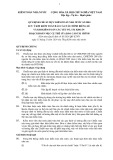


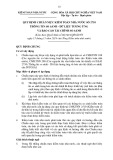
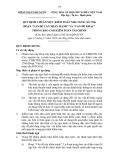





![Ngân hàng câu hỏi trắc nghiệm Lý thuyết Tài chính - Tiền tệ: Học phần [Mô tả thêm về nội dung học phần nếu có]](https://cdn.tailieu.vn/images/document/thumbnail/2025/20251003/kimphuong1001/135x160/26991759476043.jpg)
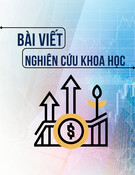
![Bài tập Tài chính doanh nghiệp có đáp án [kèm lời giải chi tiết]](https://cdn.tailieu.vn/images/document/thumbnail/2025/20250927/aimy1105nd@gmail.com/135x160/92021759119232.jpg)





